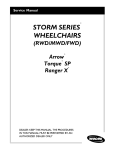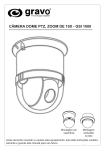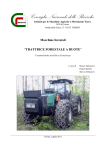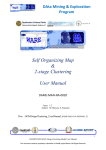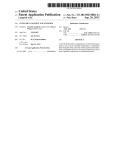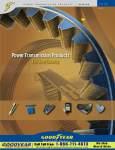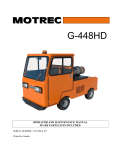Download Parts of a Tire Tires
Transcript
After studying this chapter, you will be able to: Identify the parts of a tire and wheel. Describe different methods of tire construction. Explain tire and wheel sizes. Parts of a Tire Although there are several tire designs, all tires have the same basic parts, Figure 65-2: • Beads-Two rings that are made of steel wire and Describe tire ratings. Identify the parts of driving and nondriving hub and wheel bearing assemblies. Correctly answer ASE certification test questions requiring a knowledge of tires, wheels, hubs, and wheel bearings. This chapter introduces the various tire, wheel, and hub designs used on modem vehicles. It explains how tires and wheels are constructed to give safe and dependable service. The chapter also covers hub and wheel bearing construction for both rear- and front-wheel-drive vehicles. As a result, you will be better prepared to study later chapters on brakes, suspension systems, and wheel alignment. encased in rubber. They hold the tire sidewalls snugly against the wheel rim. • Body plies-Rubberized fabric and cords wrapped around the beads. They form the carcass, or body, of the tire. • Tread-Outer surface of the tire that contacts the road. • Sidewall-Outer part of the tire that extends from the bead to the tread. Markings on the sidewall provide information about the tire. • Belts-Sometimes used to strengthen the body plies and stiffen the tread. They lie between the tread and plies. • Liner-Thin Tires layer of rubber that is bonded to the inside of the plies. It provides a leakproof membrane for the modem tubeless tire. Automobile tires perform two basic functions: they act as a soft cushion between the road and the metal wheel, and they provide adequate traction (friction) with the road surface. Tires must transmit driving, braking, and cornering forces to the road in both good and bad weather. At the same time, they should resist punctures and wear. The tires used on early vehicles were solid rubber. Today's automotive tires are pneumatic, which means they are filled with air. Internal air pressure pushes out on the inside of the tire to support the weight of the vehicle. Today's vehicles use tubeless tires, which do not have a separate inner tube. The tire and wheel form an airtight unit. Refer to Figure 65-1. Older vehicles used inner tubes (soft, thin, leakproof rubber liners) that fit inside the tire and wheel assemblies. Tubeless tire and wheel form leakproof unit Metal wheel Air pressure pushes outward to inflate tire Figure 65-1. With tubeless tires, the tire and wheel form a leakproof unit. Air pressure pushes outward on the inside of the tire. 1241 1242 Section 11 Suspension, Steering, and Brakes may run at different angles. Also, different materials may be utilized. Three types of tires found in use today are the bias ply tire, belted bias tire, and radial tire. Bias Ply Tire Body plies In a bias ply tire, the plies run at an angle from bead to bead. The angle is reversed from ply to ply. The tread is bonded directly to the top ply. See Figure 65-3A. A bias ply tire is one of the oldest designs, and it does not use belts. The position of the plies in a bias ply tire allows the body of the tire to flex easily. This tends to improve cushioning action. A bias ply tire provides a very smooth ride on rough roads. One disadvantage of the bias ply tire is the weakness of the plies and tread, which reduces traction at high speeds and increases rolling resistance. Liner Wheel Belted Bias Tire Figure 65-2. Study the basic parts of a tire. (Goodyear) Tire Rolling Resistance Tire rolling resistance is a measurement of the amount of friction produced as the tire operates on the road surface. A high rolling resistance would increase fuel consumption and wear. Typically, rolling resistance is reduced by higher inflation pressure, proper tire design, and lower vehicle weight. Tire Construction There are many construction and design variations in tires. A different number of plies may be used. The plies Bias ply tire A belted bias tire is a bias ply tire with belts added to increase tread stiffness. The plies and belts normally run at different angles. The belts do not run around to the sidewalls-they lie under the tread area only. Usually, two stabilizer belts and two or more plies are used to improve tire performance. Look at Figure 65-3B. A belted bias tire provides a smooth ride and good traction. It also offers some reduction in rolling resistance over a bias ply tire. Radial Ply Tire A radial ply tire has plies running straight across from bead to bead, with stabilizer belts directly beneath the tread. The belts can be made of steel, flexten, fiberglass, or other materials. A typical radial tire is illustrated in Figure 65-3C. Radial Belted bias Stabilizer belts A Body ply cords run on bias B Figure 65-3. There are three basic tire types. A-Bias ply tire B-Belted Radial cord c bias tire. C-Radial body plies ply tire. (Firestone) Chapter 65 Tire, Wheel, and Wheel Bearing Fundamentals 1243 Maximum inflation pressure DOT serial number Temperature index Traction index Load index Tread wear index Maximum load Tread plies Sidewall plies Figure 65-4. Sidewall markings contain information about a tire. Study the sidewall markings on this tire. A radial tire has a very flexible sidewall and a stiff tread, giving it a very stable footprint (shape and amount of tread touching road surface). This improves safety, cornering, braking, and wear. One possible disadvantage of a radial tire is that it may produce a harder, or harsher, ride at low speeds. The stiff tread area does not give or flex as much on rough roads. Tire Markings Tire markings on the sidewall of a tire give information about tire size, tire model, load-carrying ability, inflation pressure, number of plies, speed rating, manufacturer, etc. It is important that you understand these tire markings. Refer to Figure 65-4. Tire Size Tire size is given on the sidewall as a letter-number sequence. There are two common size designations: alpha-numeric (conventional measuring system) and P-metric (metric measuring system). The P-metric size designation is the newest tire identification system. It uses metric values and international standards. Look at Figure 65-5A. The letter "P" indicates that the tire is designed for use on a passenger car. The first number, 155, gives section width in millimeters. The second number, 80, is the aspect ratio (height-to-width ratio). The R indicates radial (B means belted bias and D means bias ply). The last number, 13, shows the rim diameter in inches (not metric values). The alpha-numeric (alphabetical-numerical) tire size designation uses letters and numbers to denote tire size in inches and its load-carrying capacity in pounds. An example is given in Figure 65-5B. The first letter, G, indicates the load and size relationship. The higher the letter, the larger the size and load-carrying ability of the tire. G is smaller than H, for example. The second letter, R, means that the tire is a radial. Bias and belted bias tires do not have a second letter. The first number, 78, is the aspect, or 1244 Section 11 Suspension, Steering, and Brakes P-metric tire size: P 155/80 R-13 ~ A Type tire (P=passenger car) (T=temporary) (C=commercial) ~ Section width in millimeters Height-towidth ratio (155, 185, 195) (70,75,80) I Alpha-numeric GR Load/size relationship (E, F, G) B Rim or wheel diameter in inches (R=radial) (B=bias belted) (D=diag. bias) (13,14,15,16) tire size: 78-15 ~I Radial design Figure 65-5. Note the two tire size designations. A-P-metric Tire construction Height-to-width ratio Rim or wheel diameter in inches (65,70,78) (13,14,15) designation. B-Alpha-numeric designation. t Overall diameter I ~Width~ is 70% of width UHeight t 70-series tire aspect ratio = 70 IU~~~ T t r-Width-1 of width 65-series tire aspect ratio = 65 Figure 65-7. The aspect ratio is the height-to-width ratio of tire. Note that a 65 series tire is wider and shorter than a 70 series tire. Figure 65-6. Points of measurement on a tire. These dimensions are important when ordering new tires or wheels. (B.F. Goodrich) height-to-width, ratio. The last number, 15, is the rim diameter in inches. The points of measure for a tire are given in Figure 65-6. Aspect Ratio The aspect ratio, or height-to-width ratio, in the tire size designation is the most difficult value to understand. See Figure 65-7. Note that, as the number becomes smaller, the tire becomes more squat (wider and shorter). The aspect ratio is the comparison of the tire's height (bead-to-tread distance) and width (sidewall-to-sidewall distance). A 70-series tire, for example, has an aspect ratio of 70; the height of the tire is 70 percent of the width. A 60 series tire would be "short" and "fat." A 78 tire would be "narrow" and "tall." Maximum Load Rating The maximum load rating of a tire indicates the amount of weight the tire can carry at the recommended inflation pressure. The maximum load value-1500 pounds, for example-is printed on the sidewall. With P-metric tire designations, the load rating is simply given in kilograms and pounds. The alphanumeric load rating is indicated by a letter. Most alphanumeric size tires are load range B. They are restricted to the load specified at 32 psi (220 kPa). Where a greater load carrying ability is needed, load range C or D tires are used. Chapter 65 Tire, Wheel, and Wheel Bearing Fundamentals Maximum Inflation Pressure The maximum inflation pressure is the highest air pressure that should be pumped into the tire. Many tires have a maximum recommended inflation pressure of 32 psi (220 kPa). However, tires with higher load ranges can hold higher pressures and carry more weight. Tread Plies The tire sidewall also includes information on the number of plies and ply rating. For example, the tire may be a 2-ply tire, a 2-ply with a 4-ply rating (plies made stronger than normal), or a 4-ply tire. A greater number of plies or a higher ply rating generally indicates a greater load-carrying ability. Sidewall Plies The number of sidewall plies is also shown on the tire sidewall. DOT Serial Number DOT stands for Department Of Transportation. When you see "DOT" on the tire sidewall, the tire has passed prescribed safety tests. Following the letters DOT is the DOT serial number, which identifies the particular tire manufacturer, plant location, construction, and date of manufacture. The DOT serial number is stamped into the tire sidewall. 1245 Special Tires and Tire Features You should be familiar with several types of special tires and tire features. The automotive technician will encounter compact spare tires, self-sealing tires, retreads, and run-flat tires. Asymmetric Tires Asymmetric tires have a different tread pattern on the inner edge than the outer edge. The outer tread pattern is designed to improve cornering on dry surfaces. The inner tread pattern is designed to improve traction on wet surfaces. An asymmetric tire must be mounted so the proper edge faces the outside of the wheel. This type of tire is generally marked with the word outside to indicate which way it should be mounted on the wheel. Directional Tires Directional tires are high-performance tires designed to rotate in a specific direction to minimize hydroplaning. Hydroplaning is a loss of control that occurs when layer of water prevents the tire tread from contacting the road surface. Directional tires have an arrow and the word rotation molded onto their sidewalls. Care must be taken to mount directional tires in the proper location so they rotate in the desired direction. Tire Grades Tread wear, traction, and temperature grades are normally shown on the tire sidewall according to the Uniform Tire Quality Grading System. Tread wear is given as a number. Tread wear ratings range from 100 to 500. The higher the number, the more resistant the tire is to wear. Tire traction is given an A, B, or C rating. A tire with an A rating would provide the most traction, while a tire with a C rating would provide the least traction. Tire temperature resistance is also given as an A, B, or C rating. A tire with an A rating resists a temperature buildup better than a tire with a B or Crating. Speed Rating A tire speed rating is the maximum allowable sustained road speed a tire can safely withstand without failure. Speed ratings range from B (31 mph or 50 km/h) to Z (149 mph or 238 km/h). It is important that the speed rating of a tire be higher than the speed at which the vehicle will be driven. If too low a speed rating is used, the tire could fail and cause a fatal accident. This is extremely important if the vehicle is to be driven in areas where there is no speed limit (some states and foreign countries). Spare Tires A spare tire, or spare, is an extra wheel and tire assembly that can be installed if the vehicle has a flat tire. The spare can be a full-size tire or a compact tire. A full-size spare is a tire of the same size and type used on the other four wheels of the vehicle. It can be mounted and used like any other tire. It is being replaced by compact, lighter spare tires. Most new cars use a compact spare tire, or space saver spare, which is much smaller than the normal tire used on the vehicle. It saves space in the trunk or storage area. See Figure 65-8. A high-pressure spare is a compact spare tire that holds higher-than-normal air pressure (typically about 60 psi). It is inflated when in the trunk and is ready for use. Some spare tires are not inflated when in storage. A small bottle of compressed air may be used to inflate the tire when needed. A lightweight spare tire has very thin sidewall and tread construction. Being light, it can be more easily picked up and mounted on the vehicle. However, the driving range and maximum speed rating of a lightweight spare are generally lower than those for a compact spare. 1246 Section 11 Suspension, Steering, and Brakes Run-flat construction Reinforced sidewall Inflation pressure Standard tire Figure 65-8. A compact spare tire is for temporary use only. This one should be inflated to 60 psi (415 kPa). It requires a special narrow wheel. (Oldsmobile) Tech Tip! Most modem spare tires are designed for temporary use only. Refer to the manufacturer's specifications on inflation pressure, maximum driving speed, and the number of miles that can be driven. Most compact spares should not be used at speeds over 50 mph and will last only a few thousand miles. Self-Sealing Tires Some tires are self-sealing (seal small punctures). These tires have a coating of sealing compound applied to their liners. If a nail punctures a self-sealing tire, air pressure will push the soft compound into the hole to stop air leakage. Refer to Figure 65-9. Retreads Retreads are used tires that have had a new tread vul- Run-flat tire Figure 65-10. Compare the construction of a run-flat tire to that of a conventional tire. (Bridgestone) on passenger cars. However, large truck tires are frequently recapped because of the high cost of new truck tires. Run-Flat Tires Run-flat tires have an extremely stiff sidewall construction so that they are still usable with a loss of air pressure. If the tire leaks, you can drive the vehicle to a repair shop without tire and wheel damage. See Figure 65-10. The tire will retain most of its shape because the sidewall is strong enough to support vehicle weight. The tire uses a special rubber compound and a thick rubber sidewall support insert that helps support the weight of the vehicle. Wear Bars Wear bars are used to indicate a critical amount of tread wear. When too much tread has worn from the tires, solid rubber bars will show up across the tread. This tells the customer and the technician that tire replacement is needed. Look at Figure 65-11. canized (applied using heat and pressure) to the old carcass, or body. Retreads, also called recaps, are seldom used Tread wear indicators Figure 65-9. Self-sealing tire action. A-Nail punctures the tire. B-Nail is pulled out. C-Sealing compound flows into the hole to prevent air from leaking out. (GMC) Figure 65-11. When wear bars are visible, a tire is worn enough to be unsafe and should be replaced. (General Motors) Chapter 65 Tire Pressure Monitoring Systems vehicles are equipped with tire pressure monitoring systems, which alert the driver if one or more of the vehicle's tires is underinflated. There Many late-model are two types of tire inflation systems used in late-model vehicles: direct systems and indirect systems. Direct tire pressure monitoring systems use a pressure sensor/transmitter mounted at each wheel. In some Tire, Wheel, and Wheel Bearing Fundamentals 1247 cases, these sensors are attached to the tire valves. In other designs, the sensors are held to the wheel with a metal or plastic strap. See Figure 65-12. If the tire pressure drops below a predetermined value, the sensor on the corresponding wheel will send a signal to a small receiver mounted in the passenger compartment. The receiver then turns on a dash warning light to inform the driver of the inflation problem. See Figure 65-13. Pressure sensor/transmitter Tire valve Valve stem B A Figure 65-12. Some tire pressure monitoring systems use a pressure sensor/transmitter sensor. B- This sensor is strapped to the inside of the wheel. (Ford, Chevrolet) mounted at each wheel. A-Valve-mounted Pressure sensors Warning light Pressure sensor Warning chime Sensor signal Receiver Pressure sensor Figure 65-13. If one of the pressure sensor/transmitters detects low tire pressure, it will produce a radio signal. A receiver in the passenger compartment detects the signal and triggers a warning light in the dash. (Toyota) Section 11 1248 Suspension, Steering, and Brakes In an indirect tire pressure monitoring system, the anti-lock brake system components are used to monitor tire pressure. When pressure in a tire drops, the tire's circumference is reduced. This causes the wheel and tire assembly to spin faster than the other tires. The computer interprets the speed sensor signal from the affected wheel as a drop in tire pressure and triggers a warning light. A standard wheel consists of the rim (outer lip that contacts tire bead) and the spider (center section that bolts to vehicle hub). Normally, the spider is welded to the rim. Figure 65-17 illustrates the various dimensions of a wheel. Compare this illustration with Figure 65-16. Note! All vehicles with a gross vehicle weight rating ofless than 10,000 lb sold on or after September 1, 2007, are equipped with a tire pressure monitoring system. Wheels Wheels are designed to support the tire while withstanding loads from acceleration, braking, and cornering. Most wheels are made of steel. A few optional types are cast aluminum or magnesium. Refer to Figure 65-14. Mag wheels, or mags, is a nickname for aluminum or magnesium wheels. These wheels do not need wheel covers. See Figure 65-15. A drop-center wheel is commonly used on passenger vehicles because it allows for easier installation and removal of the tire. Since the center of the wheel is smaller in diameter (dropped) than the rim, the tire bead can fall into the recess. Then, the other side of the tire bead can be forced over the rim for removal. See Figure 65-15. Aluminum or magnesium wheels are often called "mags." They do not need wheel covers. (Ford) Figure 65-16. Lug bolt holes Lug stud Pilot bore Lug nut Hub Figure 65-14. Cutaway shows many relating to a wheel. (Mercedes Benz) of the components Figure 65-16. Study the parts of this conventional wheel. drop-center Chapter 65 Tire, Wheel, and Wheel Bearing Fundamentals 1249 Safety Rims Valve Stems and Cores A safety rim has small ridges that hold the tire beads on the wheel during a tire blowout (instant rupture and air loss) or aflat (slow leak reduces inflation pressure). Small raised lips around the rim keep the tire beads from sliding into the drop-center section. This improves safety by keeping the tire from coming off the wheel. See Figure 65-18. A valve stem is pressed into a hole in the wheel of a tubeless tire to allow inflation and deflation. The stem is made of rubber. A threaded metal tube is formed in the end of the stem. See Figure 65-19. The valve core is a spring-loaded air valve that is threaded into the valve stem, Figure 65-19. The valve core allows air to be added to the tire when an air chuck (tool for filling tire with air) is placed over the valve stem. When the air chuck is removed from the valve stem, the spring pushes the valve closed to prevent air leakage. To remove air from the tire, push the center of the valve core inward. The valve will open, allowing air to escape. A valve stem cap screws over the threaded valve stem to protect the air valve and stem threads from dirt, moisture, r-- Rim width --1 I Bolt circle t • bore t diameter Rim Pilot ..•. Figure 65-17. (Goodyear) Study the spacing Rear basic I~ dimensions of a wheel. Figure 65-18. Safety ridges prevent the tire from dropping into the center well in the event of a flat or a blowout. (DaimlerChrysler) Valve -----... cap ~ ~ ~valvecoce (air valve) Figure 65-19. A-Valve stem snaps into a hole in the wheel. B- The press fit between the stem and the wheel forms an airtight seal. C- The valve core is an air valve that screws into the valve stem body. The valve cap screws over the end of the stem. (Toyota) 1250 Section 11 Suspension, Steering, and Brakes and damage. It also helps prevent accidental depression of the valve and the resulting loss of air pressure. Hub Lug Nuts, Studs, and Bolts Lug nuts hold the wheel and tire assembly on the vehicle. They fasten to special studs. The inner face of the lug nut is tapered to help center the wheelan the hub. Refer to Figure 65-20A. Lug studs are the special studs that accept the lug nuts. The studs are pressed through the back of the hub or axle flange. See Figure 65-20B. Normally, the lug nuts and studs have right-hand threads (turn clockwise to tighten). When left-hand threads are used, the nut or stud will be marked with an "L." Metric threads will be identified with an "M" or the word "Metric." A few cars use lug bolts instead of lug nuts. The bolts screw into threaded holes in the hub or axle flange. Lug nut~ Lug stud Taper helps center wheel on hub A Wheel Weights Wheel weights are small lead weights that are B attached to the wheel rim to balance the wheel-and-tire assembly, preventing vibration. The weights are used to offset a heavy area of the wheel and tire. Hub and Wheel Bearing Assemblies Figure 65-20. A-The lug nut screws onto a lug stud to secure the wheel to the hub. The tapered end of the nut must contact the wheel. The stud is pressed into the hub. B-If metric or lefthand threads are used, markings will normally be given on the nut or stud. (Cadillac) Wheel bearings allow the wheel to turn freely around the spindle, in the steering knuckle, or in the bearing support. Most wheel bearings are either tapered roller bearings or ball bearings, Figure 65-21. The wheel bearings are lubricated with heavy, hightemperature grease. This lets the elements (rollers or balls) operate with very little friction and wear. Bearing cage Inner race or ring Shaft Stationary or rotating shaft Stationary or rotating housing A Housing Outer race or ring Rotating rollers B Figure 65-21. Two basic wheel bearing configurations. A-A tapered roller bearing has cylindrical rollers that operate between inner and outer races. If the shaft is stationary, the bearing will allow the outer housing or hub to turn. If outer bearing mount is stationary, the shaft or axle can turn in the bearing. B-Ball bearings are also used as wheel bearings, especially on a vehicle's driving wheels. The balls allow parts to rotate with a minimum amount of friction and wear. (Federal Mogul) Chapter 65 Tire, Wheel, and Wheel Bearing Fundamentals • The basic parts of a wheel bearing are: • Outer race-cup or cone pressed steering knuckle, or bearing support. • Balls or rollers-antifriction into hub, washer that keeps the outer wheel bearing from rubbing on and turning the adjusting nut. elements that fit or cone that rests on spindle or drive axle shaft. There are two basic hub and wheel bearing assembly designs: those with tapered roller bearings and those with ball or straight roller bearing assemblies. Hub and Wheel Bearing AssemblyTapered Roller Bearings Tapered roller bearings can be used on both driving and non-driving. The basic parts found in a hub and tapered roller bearing assembly for a vehicle's non-driving wheels are illustrated in Figure 65-22. These parts include: • Spindle-stationary from the steering system. • shaft extending outward knuckle or the suspension Wheel bearings-tapered roller bearings mounted on the spindle and in the wheel hub. • Hub-outer housing that holds the brake disc or drum, front wheel, grease, and wheel bearings. Grease seal-seal that prevents the loss of lubricant from the inner end of the spindle and hub. • Safety washer-flat between inner and outer races. • Inner race-cup 1251 • Spindle adjusting nut-nut that is threaded on end of the spindle for adjusting the wheel bearing. • Nut lock-thin, slotted nut that fits over the spindle adjusting nut. • Cotterpin-soft metal pin that fits through a hole in the spindle, adjusting nut, and nut lock to keep the adjusting nut from turning in service. • Dust cap-metal cap that fits over the outer end of the hub to keep grease in and road dirt out of bearings. Since this hub and wheel bearing assembly does not transfer driving power, the spindle is stationary. It simply extends outward and provides a mounting place for the wheel bearings, hub, and wheel. When the vehicle is moving, the wheel and hub spin on the bearings and spindle. The hub simply freewheels. The hub is partially filled with grease to lubricate the bearings. Figure 65-23 shows a disassembled view of a nondriving front bearing and hub assembly. Compare these parts to the ones in Figure 65-22. Figure 65-24 shows the front drive hub and wheel bearing assembly for a four-wheel-drive vehicle. N"ote that it has a driving axle that extends through a stationary spindle. A special free-wheel, or locking, hub transfers power from the axle to the hub-disc assembly. Hub and Wheel Bearing Assembly-Ball or Straight Roller Bearings Cotter pin Dust cap Grease Ball bearings and straight roller bearings are often used at both driving and non-driving wheels. In most cases, the bearings are part of an assembly that includes the inner and outer races. The assembly is pressed into the steering knuckle or support. Figure 65-25 illustrates the basic parts found in a hub and wheel bearing assembly for the driving wheel of a front-wheel-drive vehicle. These parts include: • Figure 65-22. Typical non-driving, or freewheeling, hub and wheel bearing assembly for the front or rear of a car. Two tapered roller bearings allow the hub and wheel to revolve around the stationary spindle. Grease partially fills the hub to lubricate the bearings. An inner seal prevents the loss of grease. A nut on the end of the spindle allows adjustment of the bearing preload. (DaimlerChrysler) Outer drive axle-stub axle shaft that extends through the bearings and is splined to the hub. • Ball bearings-antifriction elements that allow the drive axle to turn in the steering knuckle or bearing support. 1252 Section 11 Suspension, Steering, and Brakes L ~~~ I~:~~~, I ~~~' I 9?: i!dl'@@)O)' pin 1nut 0 Ut er wheel . ~:::fJJ Cone-and- Lug nut I~::~ roller assembly bearing Wheel cover tlea,,"g J~~:~I Figure 65-23. Disassembled view of a nondriving hub and wheel bearing assembly. Note the part names and relationships. This type of assembly can be used on the front of rear-wheel-drive cars or the rear of front-wheel-drive vehicles. (Florida Dept. of Voc. Ed.) • Steering knuckle or bearing support-steering or suspension component that holds the wheel bearings, axle stub shaft, and hub. • Driving hub-mounting place for the wheel; transfers driving power from the stub axle to the wheel. • Axle washer-special washer that fits between the hub and locknut. • Grease seal-prevents lubricant loss between the inside of the axle and the knuckle or bearing support. Figure 65-26 shows an exploded view of another type of driving hub and wheel bearing assembly. Compare it to Figure 65-25. Other Hub and Wheel Bearing Assemblies Modern vehicles use a wide variation of hub and • Hub or axle locknut-nut that screws on the end of the drive axle stub shaft to secure the hub and other parts of assembly. wheel bearing assemblies. For example, many late-model vehicles use a sealed hub and bearing assembly that contains either ball bearings, straight roller bearipgs, or Outer bearing; Hub with disc assembly nut Adjusting Flange and gasket @-@-~~-~ Thrust washer LLocknut L~k washer Figure 65-24. This front hub and wheel bearing assembly is used in a four-wheel-drive vehicle. Compare this unit to those shown earlier. Note how the drive axle sticks through a stationary spindle. An adjustable hub allows the drive axle to be connected and disconnected from the hub and wheel assembly for two- or four-wheel-drive operation. (Toyota) Chapter 65 Tire, Wheel, and Wheel Bearing Fundamentals 1253 Note! Steering knuckle (bearing support) Ball bearings and straight roller bearings are often used in solid rear drive axle assemblies to reduce friction between the axles and the housing. Detailed information on rear axle bearings can be found in Chapter 61, Differential and Rear Drive Axle Fundamentals, and Chapter 62, Differential and Rear Drive Axle Diagnosis and Repair. Power input from transaxle Drive axle shaft spins inside bearings Figure 65-25. Driving hub and wheel bearing assembly has bearings mounted in a stationary steering knuckle or a bearing support. The drive axle shaft fits through the center of the bearings. The hub is splined to axle shaft. The ball bearings are lubricated by thick, high-temperature grease. Highway History Although Michelin introduced the first steel-belted radial tire in 1948, radial tires were not standard on American vehicles until many years later. In fact, it was not until the gasoline crisis of the early 1970's that American manufacturers began the switch to radial tires as a way to improve fuel economy. By 1983, radial tires were standard equipment on all new American passenger cars. Summary tapered roller bearings. These self-contained units are not serviceable. In most cases, they are bolted to the knuckle or support. A few are press fit into the knuckle. When you need more information on a specific vehicle, always refer to the factory service manual. It will explain and illustrate the hub and wheel bearing assembly clearly. Most designs, however, will be similar. • Automobile tires perform two basic functions: they act as a soft cushion between the road and the metal wheel. Tires must also provide adequate traction (friction) with the road surface. • Car tires are pneumatic, which means they are filled with air. Front wheel bearing assembly _------~A~------_ Disc-tohub screw Steering knuckle (bearing support) Figure 65-26. Disassembled view of a driving hub and wheel bearing assembly. Study the names of the parts. This type of assembly is commonly used on the front of front-wheel-drive vehicles. However, it can also be found on rear-engine, rear-wheel-drive sports cars. (Honda) 1254 • • Section 11 Suspension, Steering, and Brakes Today's vehicles use tubeless tires, which do not have a separate inner tube. The tire and wheel form an airtight unit. Tire rolling resistance is a measurement of the amount of friction produced as the tire operates on the road surface. • A bias ply tire has plies running at an angle from bead to bead. • A belted bias tire is a bias tire with belts added to increase tread stiffness. • A radial ply tire has plies running straight across from bead to bead with stabilizer belts directly beneath the tread. • Tire markings on the sidewall of a tire give information about tire size, load carrying ability, inflation pressure, number of plies, identification numbers, quality ratings, and manufacturer. • Tire size is given on the sidewall as a letternumber sequence. • The aspect ratio, or height-to-width ratio, is a comparison of the tire's height and width. • The maximum load rating of a tire indicates the amount of weight the tire can carry at recommended inflation pressure. • The maximum inflation pressure, printed on the tire sidewall, is the highest air pressure that should be pumped into the tire. • A tire speed rating is the maximum allowable sustained road speed the tire can safely withstand without failure. • Some tires are self-sealing (seal small punctures) because of a coating of sealing compound applied to the tire liner. • Retreads are old, used tires that have had a new tread vulcanized (applied using heat and pressure) to the old carcass or body. • Run-flat tires have an extremely stiff sidewall construction so that they are still usable with a loss of air pressure. • A tire pressure monitoring system can detect low tire pressure and alert the driver if one or more tires is underinflated. • A drop-center wheel is commonly used on passenger vehicles because it allows for easier installation and removal of the tire. • A valve stem snaps into a hole in the wheel of a tubeless tire to allow inflation and deflation. • Lug nuts hold the wheel and tire assembly on the vehicle. • Wheel weights are small lead weights attached to the wheel rim to balance the wheel-and-tire assembly and prevent vibration. Important Terms Tires Pneumatic Tubeless tires Beads Body plies Tread Sidewall Belts Liner Tire rolling resistance Bias ply tire Belted bias tire Radial ply tire Tire markings Tire size P-metric Alpha-numeric Aspect ratio Maximum load rating Maximum inflation pressure DOT serial number Tread wear Tire traction Tire temperature resistance . Tire speed rating Asymmetric tires Directional tires Hydroplaning Spare tire Self-sealing Run-flat tires Wear bars Tire pressure monitoring system Wheels Drop-center wheel Safety rim Valve stem Valve core Lug nuts Lug studs Lug bolts Wheel weights Wheel bearings Hub and wheel bearing assembly Review Questions-Chapter 65 Please do not write in this text. Place your answers on a separate sheet of paper. 1. What are the two basic functions of a tire? 2. Car tires are __ filled with air. , which means that they are 3. List and explain the six major parts of a tire. 4. Tire __ __ is a measurement of the amount of friction produced as the tire operates on the road surface. 5. Which of the following is not a type of tire used on passenger cars? (A) Radial. (B) Bias ply. (C) Lateral ply. (D) Belted bias. 6. What information is commonly given on the tire sidewall? Chapter 65 7. A typical tire inflation pressure would be 22 psi (152 kPa). True or False? 8. How does a self-sealing tire work? 9. A(n) has small ridges that hold the tire on the wheel during a blowout. 10. Explain why a valve core is needed. 11. are attached to the rim to balance the wheel-and-tire assembly and prevent vibration. 12. Name and describe the basic parts of a wheel bearing. 13. List and explain the nine basic parts of a hub and tapered roller bearing assembly. 14. List and explain the seven basic parts of a hub and ball bearing assembly. 15. A sealed hub and bearing assembly is not serviceable. True or False? ASE- Type Questions 1. Technician A says one of the functions of an automotive tire is to provide a cushion between the road and the metal wheel. Technician B says one of the functions of an automotive tire is to provide adequate traction with the road surface. Who is right? (A) A only. (B) B only. (C) Both A and B. (D) Neither A nor B. 2. Technician A says automotive tires are pneumatic. Technician B says modern automotive tires are not pneumatic. Who is right? (A) A only. (B) B only. (C) Both A and B. (D) Neither A nor B. 3. Technician A says older vehicles used tires equipped with inner tubes. Technician B says vehicles always came from the factory equipped with tubeless tires. Who is right? (A) A only. (B) B only. (C) Both A and B. (D) Neither A nor B. Tire, Wheel, and Wheel Bearing Fundamentals 1255 4. Technician A says an automotive tire's beads are used to stiffen the tire treads. Technician B says an automotive tire's beads are used to hold the sidewalls against the wheel rim. Who is right? (A) A only. (B) B only. (C) Both A and B. (D) Neither A nor B. 5. Technician A says an automotive tire's body plies provide a leakproof membrane for modern tubeless tires. Technician B says an automotive tire's liner provides a leakproof membrane for modern tubeless tires. Who is right? (A) A only. (B) B only. (C) Both A and B. (D) Neither A nor B. 6. Technician A says an automotive tire's belts form the body of the tire. Technician B says an automotive tire's belts are sometimes used to strengthen the plies and stiffen the treads. Who is right? (A) A only. (B) B only. (C) Both A and B. (D) Neither A nor B. 7. Technician A says tire "rolling resistance" is normally reduced by lower inflation pressure. Technician B says tire "rolling resistance'"' is normally reduced by higher inflation pressure. Who is right? (A) A only. (B) B only. (C) Both A and B. (D) Neither A nor B. 8. Technician A says "belted bias" tires provide a smooth ride and good traction. Technician B says "radial" tires have a very stable footprint. Who is right? (A) A only. (B) B only. (C) Both A and B. (D) Neither A nor B. 1256 Section 11 Suspension, Steering, and Brakes 9. Technician A says a "bias ply tire" is one of the newest tire designs and is equipped with belts. Technician B says a "bias ply tire" is one of the oldest tire designs and does not use belts. Who is right? (A) A only. (B) B only. (C) Both A and B. (D) Neither A nor B. 10. Technician A says a radial ply tire's belts are sometimes made of steel. Technician B says a radial ply tire's belts are sometimes made of fiberglass. Who is right? (A) A only. (B) B only. (C) Both A and B. (D) Neither A nor B. 11. Technician A says tire markings on the sidewall of a tire give information about tire loadcarrying ability. Technician B says tire markings on the sidewall of a tire provide the maximum recommended inflation pressure. Who is right? (A) A only. (B) B only. (C) Both A and B. (D) Neither A nor B. 12. Technician A says most automotive wheels are made of steel. Technician B says most automotive wheels are made of aluminum. Who is right? (A) A only. (B) B only. (C) Both A and B. (D) Neither A nor B. 13. Technician A says wheel bearings in several car models are the tapered roller bearing type. Technician B says wheel bearings in certain car models are the ball bearing type. Who is . right? (A) A only. (B) B only. (C) Both A and B. (D) Neither A nor B. 14. While discussing the basic parts of an automotive wheel bearing, Technician A says the bearing's outer race is sometimes pressed into the automobile's steering knuckle. Technician B says a wheel bearing's outer race is sometimes pressed into the hub. Who is right? (A) A only. (B) B only. (C) Both A and B. (D) Neither A nor B. 15. Technician A says a steering knuckle is a basic component in a driving hub and wheel bearing assembly. Technician B says an inner drive axle is a basic component in a driving hub and wheel bearing assembly. Who is right? (A) A only. (B) B only. (C) Both A and B. (D) Neither A nor B. Activities-Chapter 65 1. Using a section of an old worn tire, prepare a cutaway teaching aid showing the different parts and layers of the tire. 2. Prepare an overhead transparency that explains tire and wheel sizes and tire ratings. 3. As a classroom demonstration, disassemble and identify the parts of a hub.

















